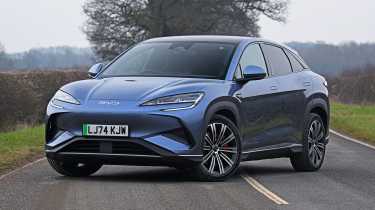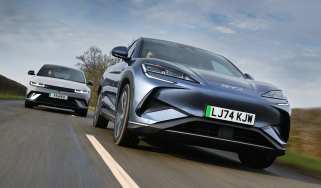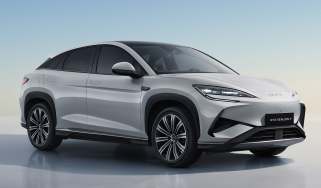BYD Sealion 7 review
The Chinese, electric family SUV is strong on space and kit but doesn’t drive as sweetly as some in this competitive segment

Our opinion of the BYD Sealion 7
There’s a lot going for the BYD Sealion 7, with a long list of standard equipment, powerful electric powertrains and among the best warranty and breakdown coverage anywhere on the market. It’s a spacious SUV for passengers, too, with lots of rear legroom, although headroom could be better.
But it’s not all good news, because the Sealion 7 isn’t as good as its rivals to drive, with a poor mix of ride and handling, while the over-sensitive safety systems will be a frustration to many. And despite the promise of strong performance, the top-spec cars don’t deliver the kind of punch we expect from an electric car – they’re expensive, too. It’s a decent first attempt by BYD, but there’s plenty to work on for the facelift.
| Key specs | |
| Fuel type | Electric |
| Body style | Five-door, five seat compact SUV |
| Powertrain | 1x e-motor, 82.5kWh battery, rear-wheel drive 2x e-motors, 82.5kWh battery, four wheel drive 2x e-motors, 91.3kWh battery, four wheel drive |
| Safety | 5-stars (Euro NCAP, 2025) |
| Warranty | Six years/93,000 miles |
About the BYD Sealion 7
The compact electric SUV market is a busy one, but the BYD Sealion 7 has arrived to attempt to make an impact in the class. It’s the largest electric SUV yet to be offered by BYD in the UK, measuring slightly longer and wider than the BYD Seal U PHEV, and its five-door, five-seat SUV shape should hold appeal for many electric family car buyers.
It’s certainly priced to be competitive, with the line-up kicking off at around £47,000 and topping out at £59,000. That puts it directly against the Tesla Model Y, and should help to draw buyers in.
There are Comfort, Design and Excellence models on offer. The Comfort version features an 82.5kWh battery and rear-wheel drive, while the Design version upgrades to four-wheel drive and has more power. It has the same battery, however, so offers a slightly shorter range as a result of the extra capability. The top-spec Excellence has the same 4x4 powertrain as Design model, but with a 91.3kWh battery, so this delivers the longest range of the line-up.
Performance & driving experience
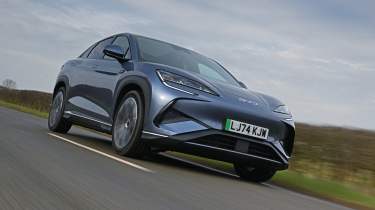
| Pros | Cons |
|
|
Sealion drivers get a choice of two battery capacities and two motor configurations spread across three models. The range starts with the Comfort, which is the only single-motor option. It sends its 308bhp and 380Nm of torque to the rear wheels.
The Comfort and the Design AWD models both feature an 82.5kWh battery. As the name suggests, the Design AWD gains four-wheel drive, courtesy of a twin-motor set-up. This extra motor to drive the front wheels bumps the Design’s overall output to 523bhp and 690Nm of torque, while this model benefits from a range of chassis, braking and other performance upgrades to handle the increase in power. The Excellence version has the same power output, but comes with a larger 91.3kWh battery.
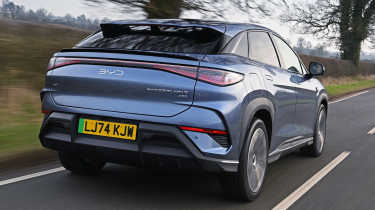
Electric motors, 0-60mph acceleration and top speed
The single-motor Comfort model manages 0-62mph in 6.7 seconds. All versions of the Sealion 7 have a top speed of 134mph, which is surprisingly quick for an electric SUV as most rivals are limited to lower maximums to help maximise range.
The more powerful Design AWD slashes the 0-62mph time to a very potent 4.5 seconds. That’s not as quick as a Tesla Model Y Performance or a Hyundai Ioniq 5 N but still very lively for a family SUV. Despite the extra 95kg that the bigger battery pack adds to the Excellence model, BYD claims identical performance figures when compared with the Design version.
As with the BYD Seal saloon, we found that the Sealion’s performance didn’t feel staggeringly quick in the real world – it’s by no means short of power, but it’s not mind-blowing when you put your foot down. A laggy throttle response with a long pedal travel is partly to blame, as inputs are met by a slight delay before anything happens. The long travel helps the car to be driven smoothly at low speeds, but the experience is undone by the sluggish response.
Town driving, visibility and parking
Limited visibility to the rear of the Sealion further emphasises the size of what is already a bulky car, and the superbly sharp surround-view cameras can’t quite overcome the fact that low-speed manoeuvrability is behind the best alternatives in the class. There are easier cars of this size to drive in town.
There are two levels of brake regeneration to pick from. The toggle switch on the centre console isn’t as intuitive to use as the steering wheel-mounted paddles some rivals offer, but it still beats diving into an on-screen menu to adjust the braking force. It’s better than the Tesla Model Y, where the brake regen system can’t be adjusted at all.
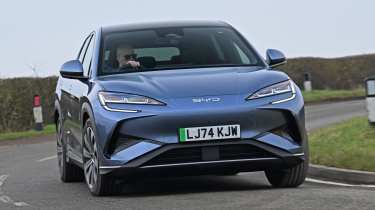
B-road driving and handling
The Sealion 7’s suspension offers neither class-leading comfort nor a reasonable level of control. The body tends to wallow a little clumsily through corners as it struggles to cope with the car’s significant mass – and that’s even by the standards of an electric SUV class where very few vehicles handle with much agility anyway.
Yet on straighter sections, the soft suspension still doesn’t cosset its occupants as well as the likes of a Hyundai Ioniq 5. A Ford Capri is much keener to drive through the turns, yet is also more compliant over bumps.
Motorway driving and long-distance comfort
These are the roads where the Sealion 7 feels most at home, although the ride still feels a little fidgety, even at higher speeds. The steering is a little too responsive yet lacking in accuracy, which means more corrections are needed to keep the BYD on line when driving at a quicker pace than in rivals.
| Model | Power | 0-62mph | Top speed |
| BYD Sealion 7 Comfort | 308bhp | 6.7 seconds | 134mph |
| BYD Sealion 7 Design AWD | 523bhp | 4.5 seconds | 134mph |
| BYD Sealion 7 Excellence AWD | 523bhp | 4.5 seconds | 134mph |
Expert view, on driving experience
“The BYD’s brake pedal is grabby and over-sharp at low speeds, yet lacks consistency and feel at high speeds. When we’re talking about a car with more than 500bhp, competent brakes really are a must.” - Jordan Katsianis, senior staff writer. Drove the BYD Sealion 7 on its European launch.
Range, charging & running costs
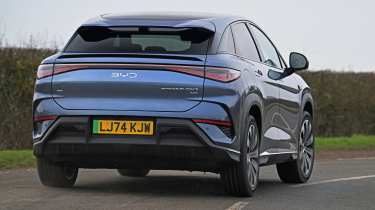
| Pros | Cons |
|
|
Prices for the BYD Sealion 7 start at around £47,000 and rise to a maximum of £59,000, but while that’s pricey for a Chinese SUV, you do get a lot of kit for your money. What’s more, BYD hasn’t left anything on the options list aside from paint, so you won’t rack up additional costs by adding extra equipment.

Electric range, battery life and charge time
The single-motor Comfort model, with a 82.5kWh battery, can officially cover 300 miles on a charge, while the flagship dual-motor Excellence has a 91.3kWh unit for a claimed 312-mile range. This version tops up quickest, and its 230kW peak charging speed can get it from 10 to 80 per cent in 18 minutes, BYD says. That’s six minutes faster than the Comfort and Design can manage to charge their smaller 82.5kWh battery unit.
The 4x4 Design model, with its dual motors and smaller battery, has the shortest range in the Sealion line-up, officially covering 283 miles. We tested this model in cold conditions – weather which doesn’t do EV battery performance any favours. As a result, our slightly underwhelming efficiency result of 2.6mi/kWh – translating into a real-world range of 215 miles – is a pessimistic estimate of what is possible. For context, that distance we managed on our test matched the efficiency of a Hyundai Ioniq 5 driven over the same week – a car which has neared closer to 4.0mi/kWh on our tests in warmer temperatures.
It’s worth noting that on our initial test drives in Germany, we found that autobahn running harmed the Sealion 7’s range. Even at 70mph, many of the alternatives to this car – particularly the Tesla Model Y and rivals from the VW Group – use less energy, so we’d look to those cars if you plan on doing lots of motorway journeys.
| Model | Battery size | Range | Insurance group |
| BYD Sealion 7 Comfort | 82.5kWh | 300 miles | 45 |
| BYD Sealion 7 Design AWD | 82.5kWh | 283 miles | 47 |
| BYD Sealion 7 Excellence AWD | 91.3kWh | 312 miles | 49 |
Insurance groups
With at least 300bhp in every model, the base BYD Sealion Comfort is in group 45 (out of 50) and the top Excellence model is in group 49.
Tax
Electric cars like the BYD Sealion 7 are no longer exempt from paying annual Vehicle Excise Duty, and due to every model in the Sealion 7 range costing comfortably beyond £40,000, all versions are subject to the expensive car surcharge. As a result, Sealion 7 owners will pay £620 per annum in VED from years two to five.
Depreciation
Sealion 7 residual values are expected to hold up fairly well. Retaining around 52 per cent of its original value after three years or 36,000 miles means that the Sealion 7 is more resistant to depreciation than the Hyundai Ioniq 5, similar to the Kia EV6 and slightly behind the Renault Scenic. That’s not bad for a relatively new brand to the UK market.
Interior, design & technology
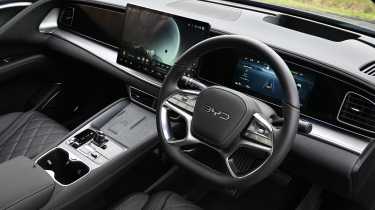
| Pros | Cons |
|
|
From the outside, the BYD Sealion 7 certainly has an expressive design by BYD’s standards, and it takes lots of cues from the BYD Seal saloon and integrates them with a fastback SUV body. However, this is a particularly busy part of the market, so it looks a little generic among more sharply styled Korean or European rivals.
Initial impressions of the Sealion 7’s interior are good, with a sleeker and more restrained cabin design than other BYD models, although the massive touchscreen does draw a lot of attention.
Interior and dashboard design
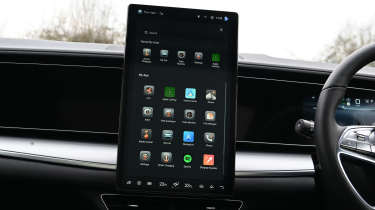
The interior is dominated by a 15.6-inch infotainment touchscreen, but look elsewhere and the cabin looks fairly smart. The flow of the dashboard into the door panels creates pleasing organic curves, and the blacklit dash panel ahead of the passenger lends the cabin a generally modern feel.
Materials and build quality
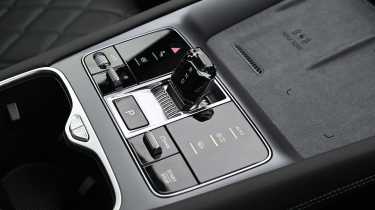
The use of leather and leather-effect materials on much of the door trims and dash point towards a feeling of expense at first glance. But some of the parts of the cabin that are touched most often, such as the internal door handles, feel a bit flimsy. When we tested the Sealion 7, our car’s head-up display rattled and vibrated while driving.
Infotainment, sat-nav and stereo
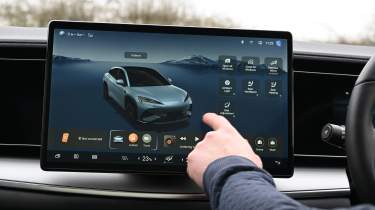
Regardless of the price point, BYD gives all its cars heaps of standard kit, and the Sealion 7 gets 20-inch alloy wheels, LED headlights, the huge 15.6-inch touchscreen display and even ultra-fast 50-watt wireless smartphone charging – including a cooling fan to prevent the device from overheating – as standard.
The 15.6-inch display with BYD’s party-piece ability to rotate 90 degrees from landscape to portrait means that the Sealion’s screen certainly looks impressive. But try to live with it, and there are things which soon start to irritate.
There are some baffling ergonomic choices here; there is a physical button for the front window demister and a second one included as a permanent fixture on the bottom of the touchscreen. But if you want to clear the rear window, the button is buried in the touchscreen’s climate sub-menu.
Another irritation with the touchscreen is when Apple CarPlay or Android Auto are connected, they completely take over the display. In order to return to the native system – something you must do to adjust the temperature, because all the climate controls are on-screen only – you need to fully exit your smartphone app. Most other models leave some of their built-in functions on the display permanently to avoid this frustration.
Expert view, on design
“One of the stand-out features is that the screen can rotate 90 degrees to change from landscape to portrait mode. But in its vertical position, a driver wearing polarised sunglasses won’t be able to read the screen, because the information displayed all but disappears from view.” - Alex Ingram, chief reviewer, tested the BYD Sealion 7 against the Hyundai Ioniq 5 in the UK
Boot space & practicality
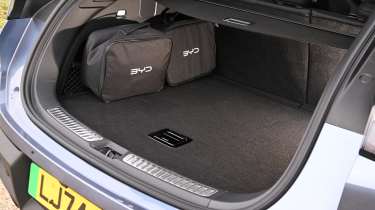
| Pros | Cons |
|
|
The Sealion 7 is a fairly large car so it’s not cramped inside. But given the size, we’d have hoped for a little more room. It comes in a conventional five-door, five-seat configuration, with only one body style offered.
| Dimensions | |
| Length | 4,830mm |
| Width | 1,925mm |
| Height | 1,620mm |
| Number of seats | Five |
| Boot space | 520-1,789 litres (plus 58 litres in the nose) |
Dimensions and size
At more than 4.8 metres, the Sealion 7 is longer than the Skoda Kodiaq, although there’s no option for seven seats here. It’s longer and wider than a Tesla Model Y, too.
Driving position, seats & space in the front
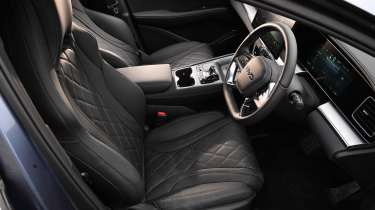
Both the front seats and steering wheel in the Sealion 7 have plenty of adjustment, so it’s fairly easy to get comfortable, but as with other BYD products, the fixed headrest is too far forward. This led to many of our testers being forced into either a hunched driving position, or reclining the seat further than usual to avoid bending their necks. This, of course, means that the seat is no longer supporting the shoulders adequately, so either way, it’s not particularly comfortable.
Among the front storage spaces are a pair of cup-holders in the centre console. Their bases can be pressed down to accommodate cups and bottles of varying heights. The deep central cubby and glovebox are lined with material to stop items from rattling around on the move.
Seats & space in the back
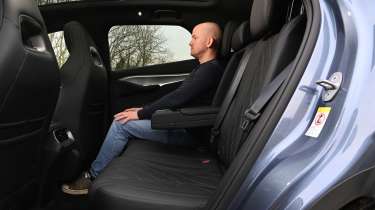
Kneeroom for back-seat passengers is excellent, with the Sealion 7 offering more space than its rivals, with the exception of the Kia EV6.
As with the Kia, however, headroom is more of an issue. The sloping roofline towards the rear of the car compromises space a little, so taller passengers could find themselves brushing against the headlining with the seats in their standard position. But the backrests can slightly recline, so those who are happy to slouch a little more can generate extra space - as long as the boot isn’t full.
There’s extra storage available in the back, too, thanks to a central armrest with a small cubby plus two pop-out cup-holders.
Boot space
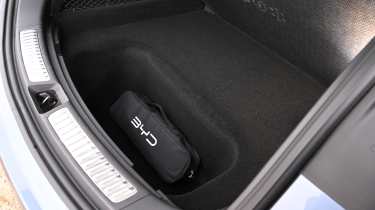
The main boot area is a generous 520 litres, and there’s a 58-litre cubby under the bonnet – perfect for storing the charging cables. Fold the back seats and the volume grows to 1,789 litres, which is 79 litres more than in a Skoda Enyaq and 209 litres more than the Hyundai Ioniq 5 in the same configuration. The folded seats leave a completely level space with the main boot floor – ideal if you need to load bulky items. Beneath the main floor area, there’s a very deep underfloor storage space, too.
Expert view, on practicality
“If there’s one element that makes it clear whether a car has been designed for the Chinese market, it’s the inclusion of lots of rear legroom, as found in the Sealion 7. It would be even lovelier to spend time there if there weren’t issues with both ride quality and refinement, which are even more noticeable in the second row.” - Jordan Katsianis, senior staff writer. Drove the BYD Sealion 7 on its European launch.
Reliability & safety
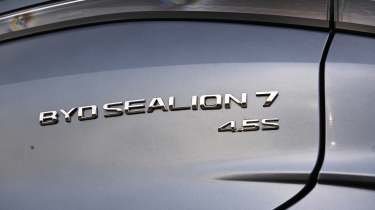
| Pros | Cons |
|
|
Euro NCAP has awarded the Sealion 7 its maximum five-star rating, scoring well in all areas. It comes with plenty of safety technology as standard, including nine airbags, a 360-degree parking camera, adaptive cruise control, blind-spot detection, lane keep assistance and traffic sign recognition.
While there’s lots of standard tech, we’re not convinced that any of it works that well. While it might tick Euro NCAP’s boxes, we found that some of these systems, most notably the lane-keep assist tech, is far too intrusive. On narrower B-roads, the car will constantly tug at the wheel, sometimes jabbing the steering wheel rather crudely towards the nearest hedgerow. Turning off these systems is much more of a faff than it is in, for example, Renault or Skoda products.
BYD is too new a brand for us to have gathered meaningful data from owners about how satisfying its products have proven to be to live with. However, in the event that anything does go wrong, owners will benefit from a standard four-year roadside assistance package.
Further adding to owners’ peace of mind is the six-year or 150,000km (93,206 miles) warranty. This is on a par with Hyundai (five years/unlimited mileage) and Kia (seven years/100,000 miles). There’s also an eight-year battery pack warranty, a term that is pretty much standard across all EV makers.
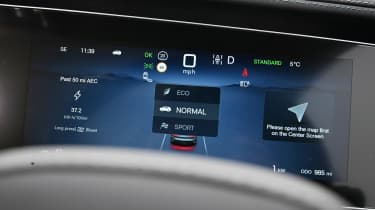
| Key standard safety features | Euro NCAP safety ratings |
|
|
Buying and owning
- Best buy: BYD Sealion 7 Comfort
The entry-level car is fast enough, and it offers a 300-mile range that should be acceptable for most needs. It also comes with lots of standard kit, so you don’t feel short-changed when compared with the higher-spec versions. This Comfort spec model is the one we’d recommend.
Alternatives
There are a broad selection of electric family SUVs to choose from. The main rival to the Sealion 7 is likely to be the Tesla Model Y, and many buyers could be drawn away from the US marque by the appearance of the latest BYD offering. Elsewhere, the Hyundai Ioniq 5, Genesis GV60 and Kia EV6 use the same running gear and are all capable family EVs, while platform sharing at the VW Group means you can choose between the VW ID.4 and ID.5, Skoda Enyaq and Cupra Tavascan as alternative options.
BYD Sealion 7 pictures
Frequently Asked Questions
You get a lot for your money, but the driving experience and overall packaging isn’t quite on a par with the market leaders from Europe and the Far East.
